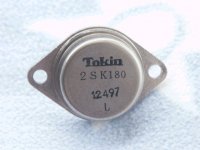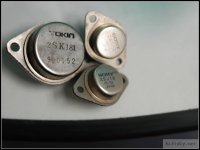Yes, it's the (in)famous Yamaha-only VFET.
You should, however, be sure you are testing it properly, as a WORKING VFET measures a near SHORT across D-S, and a diode from either D or S to G. If it is open, then it's dead
The VFET is a depletion device and is normally ON, it is essentially a power JFET.
If it indeed is dead, the only way to get a replacement is out of another B-1 amp. This transistor is completely unique.
You should, however, be sure you are testing it properly, as a WORKING VFET measures a near SHORT across D-S, and a diode from either D or S to G. If it is open, then it's dead
The VFET is a depletion device and is normally ON, it is essentially a power JFET.
If it indeed is dead, the only way to get a replacement is out of another B-1 amp. This transistor is completely unique.
Charles Hansen said:I assume these are the output devices in the funny cases.
Schwarzenegger TO3, right ? If only they had read the same script.

ilimzn said:the only way to get a replacement is out of another B-1 amp. This transistor is completely unique.
Why can't be replaced by modern Hitachi(Renesas) or Toshiba MOSFET???
Because it operates in exactly the oposite way. Practically all MOSFETs used in amps are enhancement mode, i.e. they need a control signal to turn them ON. VFETs are depletion mode (like JFETs, and tubes) and need a signal to turn them OFF. Replacing a VFET with a MOSFET (unless it was a depeltion mode MOSFET, but these are rare and currently not made for the required voltages and currents) would require a different amp topology, so essentially, you would get a different amp. You could hardly call that a replacement, more a redesign.
ilimzn said:Yes, it's the (in)famous Yamaha-only VFET.
You should, however, be sure you are testing it properly, as a WORKING VFET measures a near SHORT across D-S, and a diode from either D or S to G. If it is open, then it's dead
The VFET is a depletion device and is normally ON, it is essentially a power JFET.
If it indeed is dead, the only way to get a replacement is out of another B-1 amp. This transistor is completely unique.
What're you talking about?! Every VFET I've ever seen has been an enhancement device that does not turn on until supplied with its specific V(gson) (usually 2 -- 3Vdc).
Miles Prower said:
What're you talking about?! Every VFET I've ever seen has been an enhancement device that does not turn on until supplied with its specific V(gson) (usually 2 -- 3Vdc).
You should alow for the possibility that it exists even if you have not seen it
VFET is really a misnomer. What you are talking about is a VMOSFET, VMOS for short, unfortunately, many abbreviate this as VFET, not knowing that before there were VMOS devices, several manufacturers experimented with, and then manufactured vertical JFETs, naming them VFET. Like all JFETs, these are depletion devices. Jamaha, Sony and NEC manufactured them starting in 1975, and ending with the last Sony produced units used in their class D amp, in late 1984. For more, see here:
http://www.thevintageknob.org/VFET/VFET-main.html#
I would bet these days many would love for such devices to be available again (Look at Nelson Pass' latest offering, in fact). With current manufacturing technology, they would be practically as difficult to make as current VMOS.
VFET is really a misnomer. What you are talking about is a VMOSFET, VMOS for short, unfortunately, many abbreviate this as VFET, not knowing that before there were VMOS devices, several manufacturers experimented with, and then manufactured vertical JFETs, naming them VFET. Like all JFETs, these are depletion devices. Jamaha, Sony and NEC manufactured them starting in 1975, and ending with the last Sony produced units used in their class D amp, in late 1984.
OK, always heard those things referred to as Static Induction Transistors. Low g(m), small amp factors: no wonder that VMOS knocked 'em off. Too bad: SITs really are better analog devices than switches.
Well, the gm is not THAT low, comparable or even slightly higher than their competitor that eventually drove them out of the market, LMOS, i.e. laterals. The main reason was the manufacturing process for laterals is is very similar to what was normally used for most semiconductors at the time, whereas the VFET process was quite different, and MUCH more expensive.
VFET, however, have a very low Cgs compared to modern MOSFETs, about 150pF for the 10A/250V Sony device used in their class D amp.
VFET are true power JFETs, SITs in general have no PN junction between the channel and the gate but use a metal interface. That being said the terminology becomes somewhat blurred as different topologies come about.
VFET, however, have a very low Cgs compared to modern MOSFETs, about 150pF for the 10A/250V Sony device used in their class D amp.
VFET are true power JFETs, SITs in general have no PN junction between the channel and the gate but use a metal interface. That being said the terminology becomes somewhat blurred as different topologies come about.
YAMAHA B-1 schematic as attachment
http://www.sm.rim.or.jp/~konton/B-1.gif
2SK77 I think can replaced by NEC 2SK70, only 2SK70's Vdsx=100V and also hard to find.
http://www.sm.rim.or.jp/~konton/B-1.gif
2SK77 I think can replaced by NEC 2SK70, only 2SK70's Vdsx=100V and also hard to find.
yamaha b-1
I have trace the pwoer supply circuit, Is someone need it? Please mail me: duan.lee@msa.hinet.net
I have trace the pwoer supply circuit, Is someone need it? Please mail me: duan.lee@msa.hinet.net
Vfet are rare today, but 2SK77 is unique, bigger, and very very rare Vfet.
You can try to substitute it only with the TOKIN/NEC 2SK180 I think, but this last is also very rare.
YAMAHA B1 schematic from my site : http://www.amplimos.it/images/Yamaha%20B1.jpg
: http://www.amplimos.it/images/Yamaha%20B1.jpg
Francesco
You can try to substitute it only with the TOKIN/NEC 2SK180 I think, but this last is also very rare.
YAMAHA B1 schematic from my site
Francesco
Attachments
Last edited:
Ooops!!! The above link is only a principles schematic.
In the following the detailed design for Yamaha B1:
http://www.amplimos.it/images/2sk77%20amp%20YAMAHA%20B-1.gif
If everyone have interesting, also i have the datasheet and the curves for 2sk180
Francesco.
In the following the detailed design for Yamaha B1:
http://www.amplimos.it/images/2sk77%20amp%20YAMAHA%20B-1.gif
If everyone have interesting, also i have the datasheet and the curves for 2sk180
Francesco.
Last edited:
digital-do-main use these
2SK77B in their amps, but I think they are custom/exclusive to them?
Regards
James
An externally hosted image should be here but it was not working when we last tested it.
2SK77B in their amps, but I think they are custom/exclusive to them?
Regards
James
- Status
- This old topic is closed. If you want to reopen this topic, contact a moderator using the "Report Post" button.
- Home
- Amplifiers
- Solid State
- 2sk77

